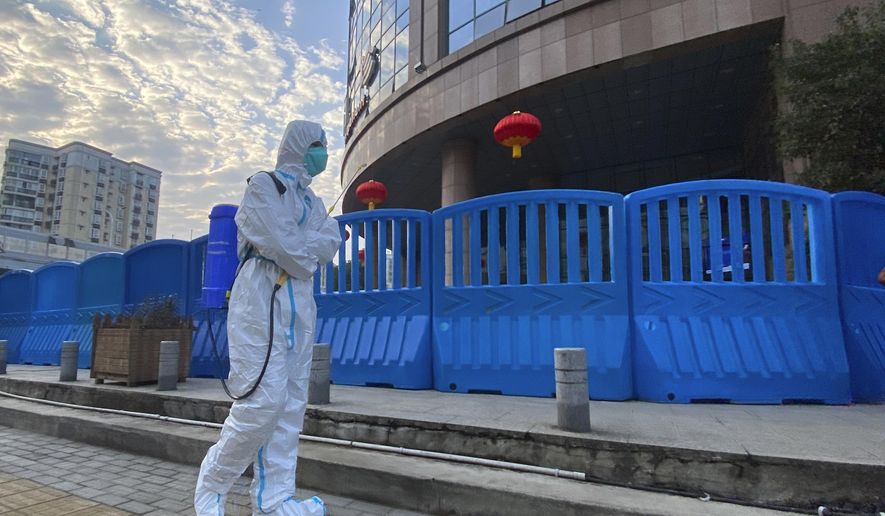GENEVA (AP) — More than two years after coronavirus emerged in China and after at least 6.3 million deaths have been counted worldwide from the pandemic, the World Health Organization is recommending in its strongest terms yet that a deeper probe is required into whether a lab accident may be to blame.
That stance marks a sharp reversal of the U.N. health agency’s initial assessment of the pandemic’s origins, and comes after many critics accused WHO of being too quick to dismiss or underplay a lab-leak theory that put Chinese officials on the defensive.
WHO concluded last year that it was “extremely unlikely” COVID-19 might have spilled into humans in the city of Wuhan from a lab. Many scientists suspect the coronavirus jumped into people from bats, possibly via another animal.
Yet in a report released Thursday, WHO’s expert group said “key pieces of data” to explain how the pandemic began were still missing. The scientists said the group would “remain open to any and all scientific evidence that becomes available in the future to allow for comprehensive testing of all reasonable hypotheses.”
Identifying a disease’s source in animals typically takes years. It took more than a decade for scientists to pinpoint the species of bats that were the natural reservoir for SARS, a relative of COVID-19.
WHO’s expert group also noted that since lab accidents in the past have triggered some outbreaks, the highly politicized theory could not be discounted.
The report could revive accusations that WHO initially was too accepting of Chinese government explanations early in the outbreak, which ultimately killed millions of people, sickened millions more, forced dozens of countries into lockdown and upended the world economy.
Investigations by The Associated Press found that some top WHO insiders were frustrated by China during the initial outbreak even as WHO heaped praise on Chinese President Xi Jinping. They were also upset over how China sought to clamp down on research into the origins of COVID-19.
Former U.S. President Donald Trump speculated repeatedly - without evidence - that COVID-19 was started in a Chinese lab. He also accused WHO of “ colluding” with China to cover up the initial outbreak, citing the U.N. health agency’s continued public praise of the country despite China’s refusal to share crucial data.
WHO’s expert group said WHO Director-General Tedros Adhanom Ghebreyesus sent two letters to senior Chinese government officials in February requesting information, including details about the earliest human cases of COVID-19 in the city of Wuhan. It’s unclear whether the Chinese responded.
The experts said no studies were provided to WHO that assessed the possibility of COVID-19 resulting from a laboratory leak. They said their understanding of how the coronavirus emerged was limited by several factors, including that not all research presented by Chinese scientists has been published.
Jamie Metzl, who sits on an unrelated WHO advisory group, has suggested that the Group of Seven industrialized nations set up their own COVID origins probe, saying WHO lacks the political authority, expertise and independence to conduct such a critical evaluation.
Metzl welcomed WHO’s call for a further investigation into the lab leak possibility but said it was insufficient.
“Tragically, the Chinese government is still refusing to share essential raw data and will not allow the necessary, full audit of the Wuhan labs,” he said. “Gaining access to this information is critical to both understanding how this pandemic began and preventing future pandemics.”
WHO’s expert scientists said numerous avenues of research were needed, including studies evaluating the role of wild animals, and environmental studies in places where the virus might have first spread, like the Huanan seafood market in Wuhan.
In March 2021, WHO released a report about COVID-19’s origins following a highly choreographed visit by international scientists to China. The report concluded that the disease most likely jumped into humans from bats and that there was no evidence to suggest there was a connection to a laboratory.
Yet after considerable criticism, including from some scientists on WHO’s team, WHO chief Tedros acknowledged that it was “ premature ” to rule out a lab leak and said he asked China to be more transparent in sharing information.
In its new report, WHO said the experts were given access to data that included unpublished blood samples from more than 40,000 people in Wuhan in 2019. The samples were tested for COVID-19 antibodies. None were found, suggesting the virus was not spreading widely before it was first identified in late December of that year.
WHO’s experts called for numerous studies to be done, including testing wild animals to find which species might host COVID-19. They also said the “cold chain” supply theory should be probed. China has previously advanced the idea that traces of COVID-19 on frozen packaging was causing outbreaks rather than any domestic source, a theory widely panned by outside scientists.
To investigate whether COVID-19 might have been the result of a lab accident, WHO’s experts said interviews should be conducted “with the staff in the laboratories tasked with managing and implementing biosafety and biosecurity.”
China has called the suggestion that COVID-19 began in a laboratory “ baseless ” and countered that the virus originated in American facilities, which were also known to be researching coronaviruses in animals. The Chinese government has said it supports the search for the pandemic’s origins, but that other countries should be the focus.
In a footnote to the report, WHO’s group noted that three of its own experts - scientists from China, Brazil and Russia - disagreed with the call to investigate the possibility of COVID-19 being sparked by a lab accident.
Scientists connected to WHO lamented in August 2021 that the search for the pandemic’s origins had stalled and that the window of opportunity was “closing fast.” They warned that collecting data that was now at least two years old was increasingly difficult.
For more information, visit The Washington Times COVID-19 resource page.




Please read our comment policy before commenting.